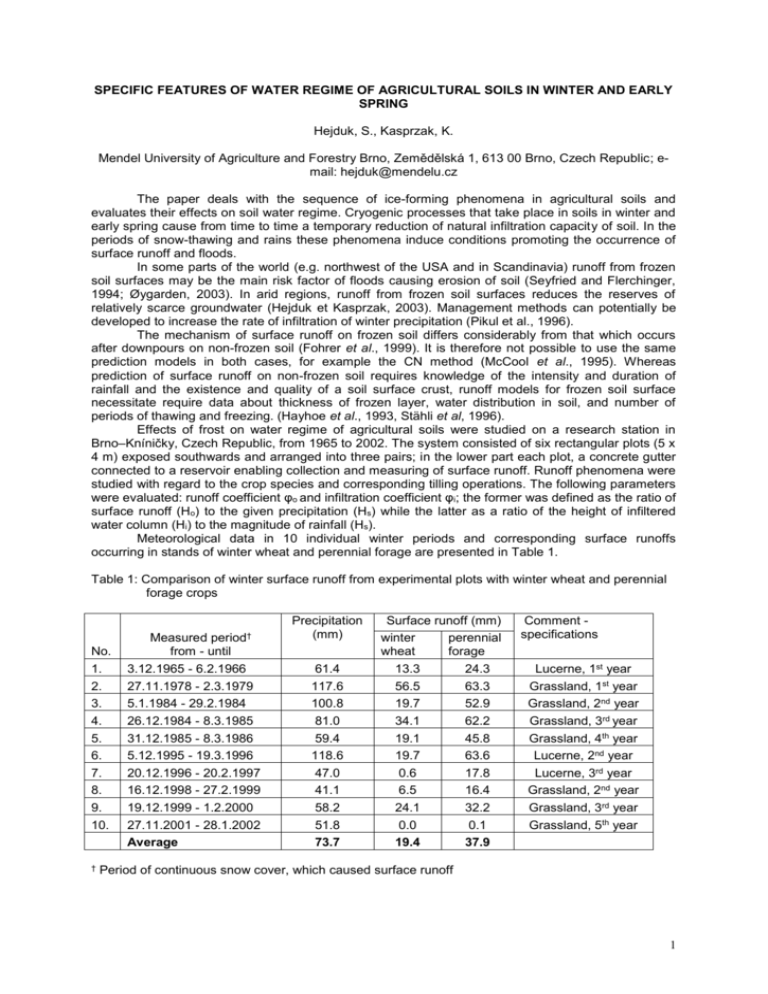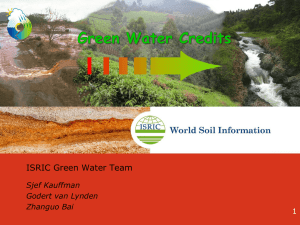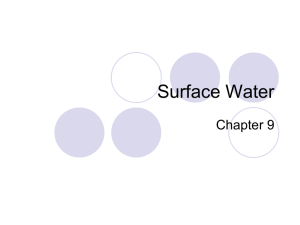Specific features of water regime of agricultural soil in winter and
advertisement

SPECIFIC FEATURES OF WATER REGIME OF AGRICULTURAL SOILS IN WINTER AND EARLY SPRING Hejduk, S., Kasprzak, K. Mendel University of Agriculture and Forestry Brno, Zemědělská 1, 613 00 Brno, Czech Republic; email: hejduk@mendelu.cz The paper deals with the sequence of ice-forming phenomena in agricultural soils and evaluates their effects on soil water regime. Cryogenic processes that take place in soils in winter and early spring cause from time to time a temporary reduction of natural infiltration capacity of soil. In the periods of snow-thawing and rains these phenomena induce conditions promoting the occurrence of surface runoff and floods. In some parts of the world (e.g. northwest of the USA and in Scandinavia) runoff from frozen soil surfaces may be the main risk factor of floods causing erosion of soil (Seyfried and Flerchinger, 1994; Øygarden, 2003). In arid regions, runoff from frozen soil surfaces reduces the reserves of relatively scarce groundwater (Hejduk et Kasprzak, 2003). Management methods can potentially be developed to increase the rate of infiltration of winter precipitation (Pikul et al., 1996). The mechanism of surface runoff on frozen soil differs considerably from that which occurs after downpours on non-frozen soil (Fohrer et al., 1999). It is therefore not possible to use the same prediction models in both cases, for example the CN method (McCool et al., 1995). Whereas prediction of surface runoff on non-frozen soil requires knowledge of the intensity and duration of rainfall and the existence and quality of a soil surface crust, runoff models for frozen soil surface necessitate require data about thickness of frozen layer, water distribution in soil, and number of periods of thawing and freezing. (Hayhoe et al., 1993, Stähli et al, 1996). Effects of frost on water regime of agricultural soils were studied on a research station in Brno–Kníničky, Czech Republic, from 1965 to 2002. The system consisted of six rectangular plots (5 x 4 m) exposed southwards and arranged into three pairs; in the lower part each plot, a concrete gutter connected to a reservoir enabling collection and measuring of surface runoff. Runoff phenomena were studied with regard to the crop species and corresponding tilling operations. The following parameters were evaluated: runoff coefficient φo and infiltration coefficient φi; the former was defined as the ratio of surface runoff (Ho) to the given precipitation (Hs) while the latter as a ratio of the height of infiltered water column (Hi) to the magnitude of rainfall (Hs). Meteorological data in 10 individual winter periods and corresponding surface runoffs occurring in stands of winter wheat and perennial forage are presented in Table 1. Table 1: Comparison of winter surface runoff from experimental plots with winter wheat and perennial forage crops No. 1. 2. 3. 4. 5. 6. 7. 8. 9. 10. † Measured period† from - until 3.12.1965 - 6.2.1966 27.11.1978 - 2.3.1979 5.1.1984 - 29.2.1984 26.12.1984 - 8.3.1985 31.12.1985 - 8.3.1986 5.12.1995 - 19.3.1996 20.12.1996 - 20.2.1997 16.12.1998 - 27.2.1999 19.12.1999 - 1.2.2000 27.11.2001 - 28.1.2002 Average Precipitation (mm) 61.4 117.6 100.8 81.0 59.4 118.6 47.0 41.1 58.2 51.8 73.7 Surface runoff (mm) winter perennial wheat forage 13.3 24.3 56.5 63.3 19.7 52.9 34.1 62.2 19.1 45.8 19.7 63.6 0.6 17.8 6.5 16.4 24.1 32.2 0.0 0.1 19.4 37.9 Comment specifications Lucerne, 1st year Grassland, 1st year Grassland, 2nd year Grassland, 3rd year Grassland, 4th year Lucerne, 2nd year Lucerne, 3rd year Grassland, 2nd year Grassland, 3rd year Grassland, 5th year Period of continuous snow cover, which caused surface runoff 1 In all winter periods under study, surface runoffs from perennial fodder crops were higher than those winter wheat stands. It is assumed that the reasons of this phenomenon were increased soil porosity and a decreased intensity of upward water migration in winter wheat stands. This then resulted in a higher requirement of water for filling of soil pores and in their subsequent blockade by ice. In loosened (i.e. ploughed) soil the thickness of water-saturated frozen horizon was smaller and its duration was shorter than in settled soils without cultivation. This means that a higher percentage of winter precipitation could infiltrate into the soil. The intensity and degree of cryogenic reduction of infiltration capacity of soil is dependent on antecedent soil moisture content, winter hardness (duration and intensity of low temperatures) and character of precipitation (rain or snow) and on the presence or absence of autumn mechanical cultivation. On soils without cultivation, the decline of soil infiltration capacity occurs faster and to a higher degree than on cultivated soils. However, capacity is substantially reduced by prolonged subfreezing temperatures or frequent partial thaws with rains to the point of overwhelming the effect of mechanical cultivation. Such conditions accentuate surface runoff on slopes and waterlogging in alluvia and terrain depressions. This paper describes individual stages of freezing and thawing and analyses the risk of surface runoff during periods of sudden thawing and rain. Key words: cryopedosphere, surface runoff, periods of thawing and freezing, soil tillage, grassland References: Fohrer, N., Berkenhagen, J., Hecker, J.M., Rudolph, A., 1999, Changing soil and surface conditions during rainfall single rainstorm/subsequent rainstorms. Catena, 37:355-375 Hayhoe, H.N., Pelletier, R.G., Vliet, L.J.P.van, 1993, Estimation of snowmelt runoff in the Peace Riverregion using a soil moisture budget. Canadian Journal of Soil Science, 73 (4):489-501 Hejduk, S., Kasprzak, K., 2003, Accumulation of early-spring soil moisture reserves for some agricultural crops. Soil and Water, 2: 47–60. Scientific Studies RISWC Praha (text in Czech) McCool, D.K., Walter, M.T., King, L.G., 1995, Runoff index values for frozen soil areas of the Pacific Northwest. Journal of Soil and Water Conservation, 50, 466-469 Øygarden, L., 2003, Rill and gully development during an extreme winter runoff event in Norway. Catena 50, 217-242 Pikul, J.L., Wilkins, D.E., Aase, J.K., Zuzel, J.F., 1996, Contour ripping: a tillage strategy to improve water infiltration into frozen soil. Journal of Soil and Water Conservation, 51:76-83 Seyfried, M.S., Flerchinger, G.N., 1994, Influence of frozen soil on rangeland erosion. In: SSSA Special Publication No. 38. Variability in rangeland water erosion processes, Minneapolis, p. 67-82 Stähli, M., Jansson, P.E., Lundin, L.C., 1996, Preferential water flow in a frozen soil – a two-domain model approach. Hydrological Processes, 10:1305-1316 2







